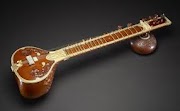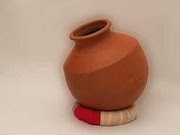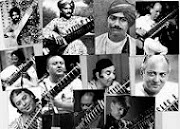Ghatam | Indian classical music instrument
Introduction of Ghatam
The ghatam is an very old Indian percussion instrument that has an enormous influence in traditional South Indian Carnatic classical music. This Ghatam is also known as bada, ghara, matka and noot. The ghatam is a round shaped earthenware pot and have a narrow opening at the top. The mouth of the pot has an external rim over a narrow neck. Different parts of Ghatam i.e the body, neck or rim of the each produce a different tone when struck. The ghatam is known for its deep, sometimes metallic sound in various pitches and often in concert performances, it is played with mridangam. Although the ghatam is made of clay but it is made in special way to be an instrument. The instrument comes in various sizes and is produced using a combination of clay, mud and often metals (brass or copper). The thickness of the pot should be even to create a quality tone. Ghatams those are made in Manamadurai are most famous in India. Manamadurai ghatam are thicker and heavier and produce a distinct sound.
History of Ghatam
The word "Ghatam" derived from the Sanskrit word "ghata" which means pot. We get the first description ghatam as an instrument in the Valmiki Ramayana. In the ancient Tamil book "Silappatikaram" also has a description of Ghatam. At first The ghatam was used as a folk instrument in several parts of India and still so. Ghatam was included in South Indian Carnatic classical music performances in the 19th century. In the 1800s, Polagam Chidambara Iyer first introduced ghatam to Carnatic concerts. later, Palani Krishna Iyer have developed rhythm patterns and playing techniques specific to the ghatam. though some ghatam players still use tabla techniques. Earlier, the ghatam was used as an extra, or auxiliary, instrument that is intended to back up the mridangam. But over the last 50 to 100 years the ghatam has gained popularity and gained popularity as solo instrument also not only in India but also in abroad even in rock and jazz music.
Types of Ghatams
Ghatams which are used in Carnatic music are made in Chennai and Manamadurai. Madras ghatam i.e ghatams made in Chennai are thinner and light weight than the Manamadurai ghatam. So Madras ghatam are easier to play for students who are just starting out learning ghatam music.
There may be some minor differences in Ghatams made by different makers but have the same colouring and dimensions to maintain the quality of sound. Manamadurai Ghatams creats a very distinct, deep, metallic sound as thery are made with brass or copper pieces.
The ghatam is played with the fingers and palms of two hands—delivering quick, complex Carnatic rhythms. Ghatam music gives the 'heartbeat' to large numbers of the pieces it goes with. The instrument is situated either on the lap of the situated player or before them on a chutta or bira, the ring-molded fabric base for tabla. In South Indian style , the opening is pressed against the player's stomach.
Famous ghatam exponents
Ganesh Anandan, Sukanya Ramagopal, Sumana Chandrashekar. Suresh Vaidyanathan. T.H. Subash Chandran. T.H. Vinayakram. T.V. Gopalakrishnan are some famous Ghatam players.




0 Comments